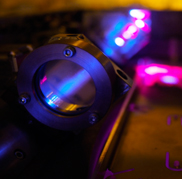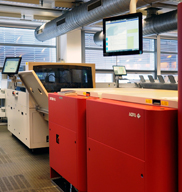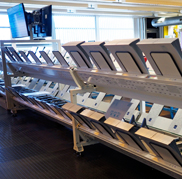


Pre-Press Department
The plate production is divided into two areas: data reception and plate exposure. When received, the incoming data records are stored on multiple servers. Depending on the print job, these are already ripped TiFF G4 records or pdf files which are placed in special templates and then ripped.
The finished pages are released for exposure via the central production control system, AGFA :Arkitex, on one of the three AGFA :Advantage N-TR-VHS, or the AGFA :Polaris XTV-S (CtP, Computer to Plate). The CTP is equipped with a laser diode with 405nm wavelength (violet light) and has a power output of 60 mW. The violet photopolymer process is characterised by very stable, high-quality exposure, very low chemical consumption, and low energy consumption. The four lines can process up to 1,315 sheets per hour.
The photosensitive polymer layer of the printing plate is cured by the impacting laser beam and prints later. The unexposed locations on the plate are detached in the clean-out unit, and the plate is gummed at the same time. The final printing form is now insensitive to light, and is passed to the punching and bending machine. There it is aligned by a video system based on recorded register marks, punched, folded, and routed to the automatic plate sorting unit. A conveyor belt feeds the printing plates to the 96 output compartments, where they are stored by product, page, printing unit or colour. In the double-deck-sorter the 1,412 printing plates can be collected for the complete rotary machine.
Gunnar Striewski
Phone: +49 89 21 83 – 80 53
Fax: +49 89 21 83 – 81 54
gunnar.striewski@sueddeutsche.de



















